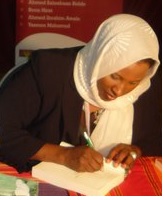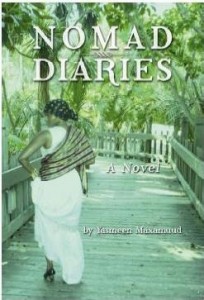Raaz for MMW: I found Nomad Diaries a wonderful introduction to the lives of Somali women living in the United States. There were times where I was reminded of my own immigrant grandmother and mother as I read about Nadifo’s life. As I mentioned in my review of Nomad Diaries, I am not familiar with stories that portray an African refugee woman’s journey to the United States presented in literature. What inspired you to write your novel?

Yasmeen Maxamuud (YM): Nomad Diaries came out of my desire to tell stories about the Somali diaspora community. I started writing about seven years ago out of a desire to communicate an issue in an article. Then came a plethora of reading about African affairs, and I didn’t like what was out there. Everyone had an opinion on Africans, but the African voice was lacking. At the time, I was reading a lot of gloomy books about Africa. Few that come to mind are King Leopold’s Ghost, about the Congo; and The Graves are Not Full about Rwanda. As I read these books, I began having one-way conversations with myself and I started asking questions. These responses became long accounts of my opinion about certain issues, like poverty, corruption, nepotism, and tribalism in Africa.
As I was grappling with my African identity, 9/11 happened, and my entire world as I knew it changed. As I emerged from my new world as a baffled African Muslim, I looked for books that spoke to me, and there were none. I wanted to read about the Somali diaspora community, I wanted books that were written by people from home and, in particular, I wanted to read books from a Somali woman’s perspective. When I didn’t find “me” in a positive light in books that were in bookstores, I decided to write so that those similar to me with questions may find some answers.
I questioned many endearing parts of my culture. One central question that kept ringing in my mind was “If we have such a beautiful Somali culture as was sold to me as a child, why are my people slaughtering each other?” In a nutshell, it’s the reason I wrote Nomad Diaries: to answer these questions for myself and to contribute to Somali literature from woman’s perspective.
Another reason for writing the book is to share our rich literature with non-Somali readers so that Somali literature is not an isolated literature in the corridors of the Somali community only but one shared by a larger global community. I wanted to give readers a viewpoint of African women they may not have encountered before.
MMW: I am struck by the image of a Somali woman on the cover of the novel: we see her back as she crosses a bridge (Book cover pictured left). Why is this Somali woman on the cover of the book?
YM: The woman on the cover of the book represents Somali women both traditional and modern. She is dressed in a traditional garb called sadex qayd. This is the traditional dress for Somali women in the countryside. My sister designed this particular sadex qayd for her wedding in America.
As for the cover photograph, I wanted to capture the essence of a Somali woman moving forward while looking back into the past. The quintessential Somali woman in the American diaspora is one at the helm of her present life while continuously looking back into what she has lost in the civil war. Likewise, I desired for the cover to capture the past, the traditional, and the present modern Somali woman.
 MMW: The voices of African Muslim women are rarely portrayed in a positive light, either by themselves or by others in the media, if at all. Instead, stories illustrate the despairing situations women find themselves in with little to no mention of African women who work daily to overcome the challenges they face. Why do you think that is? Did this affect your decision to self-publish the novel?
MMW: The voices of African Muslim women are rarely portrayed in a positive light, either by themselves or by others in the media, if at all. Instead, stories illustrate the despairing situations women find themselves in with little to no mention of African women who work daily to overcome the challenges they face. Why do you think that is? Did this affect your decision to self-publish the novel?
If one believes the portrayals one sees in the Western media, one will come away thinking African Muslim women are weak and desperate and oppressed with no voice. Of course the Western media has no reason to depict Somali women in a positive light. Depicting African women in a gloomy desperate predicament has often been a story to tell. In contrast, here is a group of women who are strong, empowered, and definitely at the tiller of their own lives. Women like Nadifo are everywhere, both in Somalia and in America. They are women who have figured a niche in the American melting pot, while still adhering to traditional culture and religious practices. A portrayal that is endearing, yet challenging, and ultimately human.
It’s important to tell our own story. If I had waited for some big publisher to publish this book, I probably would have waited for years. Going on book tours has assured me that this is an important story to tell, readers everywhere were waiting it seems to hear an authentic African women’s story that is real and non-sensational. I can’t imagine anyone else telling our story the way a Somali woman can.
Read more: An Interview with Yasmeen Maxamuud
Source: Patheos
We welcome the submission of all articles for possible publication on WardheerNews.com. WardheerNews will only consider articles sent exclusively. Please email your article today . Opinions expressed in this article are those of the author and do not necessarily reflect the views of WardheerNews.
WardheerNew’s tolerance platform is engaging with diversity of opinion, political ideology and self-expression. Tolerance is a necessary ingredient for creativity and civility.Tolerance fuels tenacity and audacity.
WardheerNews waxay tixgelin gaara siinaysaa maqaaladaha sida gaarka ah loogu soo diro ee aan lagu daabicin goobo kale. Maqaalkani wuxuu ka turjumayaa aragtida Qoraaga loomana fasiran karo tan WardheerNews.
Copyright © 2024 WardheerNews, All rights reserved


